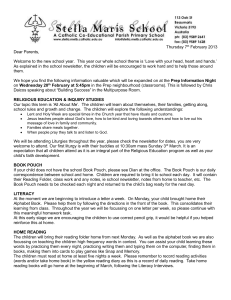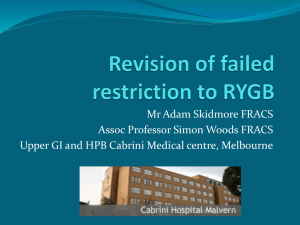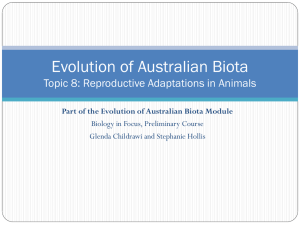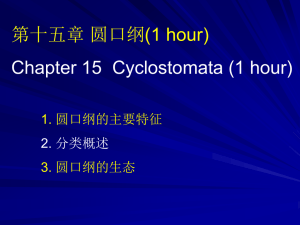FilmArray RP Procedure
advertisement
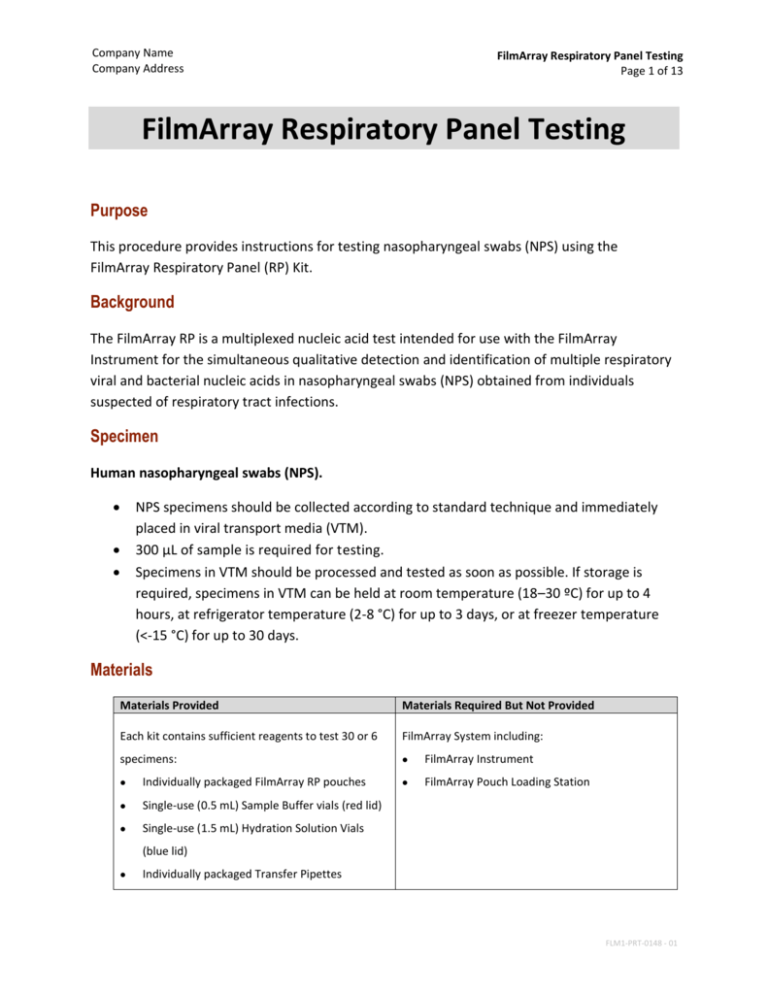
Company Name Company Address FilmArray Respiratory Panel Testing Page 1 of 13 FilmArray Respiratory Panel Testing Purpose This procedure provides instructions for testing nasopharyngeal swabs (NPS) using the FilmArray Respiratory Panel (RP) Kit. Background The FilmArray RP is a multiplexed nucleic acid test intended for use with the FilmArray Instrument for the simultaneous qualitative detection and identification of multiple respiratory viral and bacterial nucleic acids in nasopharyngeal swabs (NPS) obtained from individuals suspected of respiratory tract infections. Specimen Human nasopharyngeal swabs (NPS). NPS specimens should be collected according to standard technique and immediately placed in viral transport media (VTM). 300 µL of sample is required for testing. Specimens in VTM should be processed and tested as soon as possible. If storage is required, specimens in VTM can be held at room temperature (18–30 ºC) for up to 4 hours, at refrigerator temperature (2-8 °C) for up to 3 days, or at freezer temperature (<-15 °C) for up to 30 days. Materials Materials Provided Materials Required But Not Provided Each kit contains sufficient reagents to test 30 or 6 FilmArray System including: specimens: FilmArray Instrument Individually packaged FilmArray RP pouches FilmArray Pouch Loading Station Single-use (0.5 mL) Sample Buffer vials (red lid) Single-use (1.5 mL) Hydration Solution Vials (blue lid) Individually packaged Transfer Pipettes FLM1-PRT-0148 - 01 Company Name Company Address FilmArray Respiratory Panel Testing Page 2 of 13 Individually packaged Sample Loading Syringes with attached cannula (red cap) Individually packaged Pouch Hydration Syringes with attached cannula (blue cap) Quality Control Process Controls Two process controls are included in each pouch: 1. RNA Process Control The RNA Process Control assay targets an RNA transcript from the yeast Schizosaccharomyces pombe. The yeast is present in the pouch in a freeze-dried form and becomes rehydrated when sample is loaded. The control material is carried through all stages of the test process, including lysis, nucleic acid purification, reverse transcription, 1st stage PCR, dilution, 2nd stage PCR and DNA melting. A positive control result indicates that all steps carried out in the FilmArray RP pouch were successful. 2. PCR2 Control The PCR2 Control assay detects a DNA target that is dried into wells of the array along with the corresponding primers. A positive result indicates that 2 nd stage PCR was successful. Both control assays must be positive for the test run to pass. When either control fails, the Controls field of the test report (upper right hand corner) will display Failed and all results will be listed as Invalid. If the controls fail, the sample should be retested using a new pouch. Monitoring Test System Performance It is possible to trend Tm values for the RNA Process Control and/or PCR2 Control assays and maintain records according to standard laboratory quality control practices. The FilmArray Software will automatically fail the run if the Tm for either the RNA Process Control or the PCR2 control is outside of the acceptable range (80.6-84.6 for the RNA Process Control and 74.5-78.5 for the PCR2 control). Any trend variations should be FLM1-PRT-0148 - 01 Company Name Company Address FilmArray Respiratory Panel Testing Page 3 of 13 investigated. Contact BioFire Diagnostics Technical Support for help with out-of-range controls. NOTE: Trending for the two control assays (RNA Process Control and PCR2 Control) should be tracked on separate control charts as the expected Tm values for these two controls are different. Good laboratory practice recommends running external positive and negative controls regularly. Use viral transport medium as the external negative control, and previously characterized positive samples or negative samples spiked with well characterized organisms as external positive controls. External controls should be used in accordance with the appropriate accrediting organizations, as applicable. Procedure Refer to the FilmArray Respiratory Panel Quick Guide, the FilmArray Training Video or the FilmArray Operator’s Manual for more detail and pictorial representations of these instructions. Gloves and other Personal Protective Equipment (PPE) should be used when handling pouches and specimens. Only one FilmArray RP pouch should be loaded at a time. Once the pouch is loaded, it should be promptly transferred to the instrument to start the run. After the run is complete, the pouch should be discarded in a biohazard container. Pouch Preparation 1. Thoroughly clean the work area and the FilmArray Pouch Loading Station with freshly prepared 10% bleach (or suitable disinfectant) followed by a water rinse. 2. Remove the FilmArray RP pouch from its vacuum-sealed package by tearing or cutting the notched outer packaging and opening the protective aluminum canister. NOTE: The outer packaging should be tight around the canister prior to opening. When opening the pouch, a brief hissing noise indicates that proper vacuum was maintained during storage. DO NOT use the pouch if the vacuum has been lost. 3. Place the FilmArray Pouch into the FilmArray Pouch Loading Station. To do so, hold the pouch so that the barcoded label is upright and readable, and then slide the flexible film portion of the pouch into the slot at the base of the loading station until the rigid plastic part of the pouch clicks into place. In the correct configuration, the inlet ports on both FLM1-PRT-0148 - 01 Company Name Company Address FilmArray Respiratory Panel Testing Page 4 of 13 ends of the rigid plastic part of the pouch will point up, and the red and blue labels on the pouch will align with the red and blue arrows on the base of the FilmArray Pouch Loading Station. 4. Place a blue-capped Hydration Solution vial in the blue well of the FilmArray Pouch Loading Station. 5. Place a red-capped Sample Buffer vial in the red well of the FilmArray Pouch Loading Station. Pouch Hydration 1. Remove the blue labeled Pouch Hydration Syringe from the packaging. 2. Remove the cap from the Hydration Solution vial. 3. Using the Pouch Hydration Syringe (blue cap), draw Hydration Solution to the 1 mL mark on the syringe, taking care to avoid the formation of bubbles. If you notice bubbles at the base of the syringe, leave the tip of the cannula in the Hydration Solution vial and dislodge the bubbles by gently tapping the side of the syringe with your finger. The bubbles will float up to the plunger. NOTE: DO NOT remove air bubbles by inverting the syringe and expelling liquid. 4. Insert the cannula tip into the port in the pouch fitment located directly below the blue arrow of the FilmArray Pouch Loading Station. While holding the body of the syringe, push down forcefully in a firm and quick motion until you hear a faint “pop” and feel an ease in resistance. The correct volume of liquid will be pulled into the pouch by vacuum; there is no need to use the plunger. NOTE: DO NOT push the syringe plunger. Injecting liquid will cause the pouch to overfill. 5. Verify that the pouch has been hydrated. Most of the liquid will have been drawn out of the syringe. Also, check to see that fluid has entered and hydrated reagents in the reagent wells (eleven wells located at the base of the rigid plastic part of the pouch). Flip the barcode label down to see the reagent wells. Small air bubbles may be seen. If the pouch fails to hydrate (dry reagents FLM1-PRT-0148 - 01 Company Name Company Address FilmArray Respiratory Panel Testing Page 5 of 13 appear as white pellets), repeat Step 4 to verify that the seal of the port was broken or retrieve a new pouch and repeat from Step 2 of the Pouch Preparation section. Sample Loading 1. Remove the cap from the Sample Buffer vial. 2. Using the Transfer Pipette provided in the test kit, draw sample (NPS in VTM) to the third line (approximately 0.3 mL). Add sample to the red-capped Sample Buffer vial and gently pipette up and down to mix. Discard the Transfer Pipette in a biohazard waste container. 3. Remove the red-labeled Sample Loading Syringe from the packaging. 4. Using the Sample Loading Syringe, draw approximately 0.3 mL of sample/sample buffer mix (to the 0.3 mL/cc mark on the syringe), taking care to avoid the formation of bubbles. If you notice bubbles at the base of the syringe, leave the tip of the cannula in the Sample Buffer vial and dislodge the bubbles by gently tapping the side of the syringe with your finger. The bubbles will float up to the plunger. NOTE: To avoid contaminating the work area, DO NOT remove air bubbles by inverting the syringe and expressing liquid. 5. Insert the cannula tip into the port in the pouch fitment located directly below the red arrow of the FilmArray Pouch Loading Station. While holding the body of the syringe, push down forcefully in a firm and quick motion until you hear a faint “pop” and feel an ease in resistance. The correct volume of liquid will be pulled into the pouch by vacuum; there is no need to use the plunger. NOTE: DO NOT push the syringe plunger. Injecting liquid will cause the pouch to overfill. 6. Verify that the sample has been loaded. Most of the liquid will have been drawn out of the syringe. Flip the barcode label down and check to see that fluid has entered the reagent well next to the sample loading port. If the pouch fails to pull sample from the Sample Loading Syringe, the pouch should be discarded. Retrieve a new pouch and repeat from Step 2 of the Pouch Preparation section. FLM1-PRT-0148 - 01 Company Name Company Address FilmArray Respiratory Panel Testing Page 6 of 13 NOTE: To reduce the risk of exposure to hazardous or potentially infectious material, DO NOT re-cap the syringes. 7. Dispose of syringes in an appropriate biohazard sharps container. 8. Record the Sample ID in the provided area on the pouch label (or affix a barcoded Sample ID) and remove the pouch from the FilmArray Pouch Loading Station. Using the FilmArray Instrument to Perform the Test The FilmArray Instrument Control Software includes a step-by-step on-screen tutor that shows each step of the test. 1. Ensure that the laptop and FilmArray Instrument have been turned on. Launch the FilmArray Instrument Control Software by double clicking on the desktop icon. 2. Open the instrument lid (if not already open). 3. Insert the loaded FilmArray pouch into the instrument. Position the pouch so that the array is on the right and the film is inserted first. The red and blue labels on the FilmArray pouch should align with the red and blue arrows on the FilmArray Instrument. There is a ‘click’ when the FilmArray pouch has been placed securely in the instrument. If inserted correctly, the pouch barcode is visible. If the FilmArray pouch is not completely in place, the instrument will not continue to the next step. NOTE: If the pouch does not slide into the instrument easily, gently push the lid of the instrument back to be sure that it is completely open. 4. Scan the barcode on the FilmArray pouch using the barcode scanner. Pouch identification (Lot Number and Serial Number), Pouch Type and Protocol are preprogrammed in the rectangular barcode located on the FilmArray pouch. The information will be automatically entered when the barcode is scanned. If it is not possible to scan the barcode, the pouch Lot Number, Serial Number, Pouch Type and Protocol can be manually entered from the information provided on the pouch label into the appropriate fields. NOTE: The barcode cannot be scanned prior to placing the pouch in the instrument. A “Cannot scan now” 5. Enter the Sample ID. message will be displayed. FLM1-PRT-0148 - 01 Company Name Company Address FilmArray Respiratory Panel Testing Page 7 of 13 The Sample ID can be entered manually or scanned in by using the barcode scanner when a barcoded Sample ID is used. 6. If necessary, select a protocol from the Protocol drop down list. 7. Enter a user name and password in the Name and Password fields. 8. Close the FilmArray Instrument lid. 9. Click Start Run. Once the run has started, the screen displays a list of the steps being performed by the instrument and the number of minutes remaining in the run. NOTE: The bead-beater apparatus can be heard as a high-pitched noise (whine) during the first minute of operation. 10. When the run is finished, follow the on-screen instructions to open the instrument and remove the pouch. 11. Immediately discard the pouch in a biohazard container. 12. Results are automatically displayed in the report section of the screen. 13. Select Print to print the report, or Save to save the report as a file. Interpretation The FilmArray Software automatically analyzes and interprets the assay results and displays the final results in a test report (see the FilmArray Respiratory Panel Quick Guide to view an example of a test report). The analyses performed by the FilmArray Software and details of the test report are described below. Assay Interpretation When 2nd stage PCR is complete, the FilmArray Instrument performs a high resolution DNA melting analysis on the PCR products and measures the fluorescence signal generated in each well (for more information see FilmArray Operator’s Manual). The FilmArray Software then performs several analyses and assigns a final assay result. Analysis of melting curves. The FilmArray Software evaluates the DNA melting curve for each well of the 2nd stage PCR array to determine if a PCR product was present in that well. If the melt profile indicates the presence of a PCR product, then the analysis software calculates the melting temperature (Tm) of the curve. The Tm value is then compared FLM1-PRT-0148 - 01 Company Name Company Address FilmArray Respiratory Panel Testing Page 8 of 13 against the expected Tm range for the assay. If the software determines that the melt is positive and the melt peak falls inside the assay-specific Tm range, the curve is called positive. If the software determines that the melt is negative or is not in the appropriate Tm range, the curve is called negative. Analysis of replicates. Once melt curves have been identified, the software evaluates the three replicates for each assay to determine the assay result. For an assay to be called positive, at least two of the three associated melt curves must be called positive, and the Tm for at least two of the three positive curves must be similar (within 1°C). Assays that do not meet these criteria are called negative. Organism Interpretation. For most organisms detected by the FilmArray RP, the organism is considered to be Detected if a single corresponding assay is positive. For example, Human Metapneumovirus will have a test report result of Human Metapneumovirus Detected if at least two of the three replicates of the one Human Metapneumovirus assay have similar positive melt peaks with Tm values that are within the assay-specific Tm range. The test results for Adenovirus, the Human Rhinovirus/Enterovirus group, and Influenza A depend on the interpretation of results from several assays. Interpretation and follow-up testing for these three results are provided below. Rhinovirus/Enterovirus Group The FilmArray RP pouch contains six different assays (HRV1, HRV2, HRV3, HRV4, Entero 1, Entero 2) for the detection of Rhinoviruses and Enteroviruses. Though these viruses are both very diverse, they are also closely related. Therefore, the six assays are not able to reliably differentiate Rhinovirus and Enterovirus. The FilmArray Software interprets each of the six assays independently (as described above) and the results are combined as a final test result for the virus(es). If any of the six assays are positive, the test report result will be Human Rhinovirus/Enterovirus Detected. If all six assays are negative, the test report result will be Human Rhinovirus/Enterovirus Not Detected. A positive FilmArray RP Human Rhinovirus/Enterovirus result should be followed-up using an alternate method (e.g., viral culture or sequence analysis). NOTE: Despite the names, the HRV (1-4) and Entero (1-2) assays are not specific for detection of Human Rhinovirus or Enterovirus, respectively. Individual assay results cannot be used to differentiate these two viruses. Adenovirus FLM1-PRT-0148 - 01 Company Name Company Address FilmArray Respiratory Panel Testing Page 9 of 13 The FilmArray RP pouch contains two different assays (Adeno, Adeno2) for the detection of Adenovirus. The FilmArray Software interprets each of these assays independently (as described above) and the results are combined as a final test result for the virus. If either or both assays are positive, the test report result will be Adenovirus Detected. If both the Adeno and Adeno2 assays are negative, the test report result will be Adenovirus Not Detected. Influenza A The assays in the FilmArray RP are designed to both detect Influenza A and to differentiate commonly occurring hemagglutinin subtypes. To accomplish this, the FilmArray RP uses two Influenza A assays, (FluA-pan-1 and FluA-pan-2) and three subtyping assays directed at the hemagglutinin gene (FluA-H1-pan, FluA-H1-2009 and FluA-H3). The FluA-H1-pan assay is designed to detect both Influenza A H1 and the Influenza A H1-2009 variant. Each of the individual assays is interpreted independently (as described above) and the test result reported for Influenza A is based on the combined results of the five assays as outlined in Table 1. In general, Influenza A is determined to be Detected if at least one of the two FluApan assays is positive and a subtyping assay is also positive. If neither of the FluApan assays is positive, but a subtyping assay is positive, then the result is considered Equivocal for that specific subtype and the sample should be retested. If one of the FluA-pan assays is positive and none of the subtyping assays are positive, the result is Equivocal for Influenza A and the specimen should be retested. All Equivocal results should be retested. Table 1. Possible Assay Results for Influenza A and the Corresponding Interpretation FluA-pan Assay Assays FluA-H1FluA-H1Final Result (n=2) pan 2009 FluA-H3 Influenza A Not Detected Negative Negative Negative Negative Influenza A H1 ≥1 positive Positive Negative Negative Influenza A H3 ≥1 positive Negative Negative Positive Influenza A H1-2009 ≥1 positive Any result Positive Negative Influenza A H1 and Influenza A H3 ≥1 positive Positive Negative Positive Influenza A 2009 H1 and Influenza A H3 ≥1 positive Any result Positive Positive Required Follow-up None Multiple infections are possible but rare a, retest to confirm result b FLM1-PRT-0148 - 01 Company Name Company Address FilmArray Respiratory Panel Testing Page 10 of 13 FluA-pan Assays (n=2) FluA-H1pan FluA-H12009 FluA-H3 Required Follow-up 2 positive Negative Negative Negative See below Influenza A Equivocal 1 positive Negative Negative Negative Influenza A H1 Equivocal Negative Positive Negative Negative Influenza A H3 Equivocal Negative Negative Negative Positive Influenza A H1-2009 Equivocal Negative Any result Positive Negative Assay Final Result Influenza A (no subtype detected) a Retest FluMist® The FilmArray RP system can simultaneously detect multiple Influenza viruses contained in the nasal Influenza vaccine (see “Interference” section below). b Repeated multiple positives should be further confirmed by other FDA cleared Influenza subtyping tests. Influenza A (no subtype detected) If both of the Flu A-pan assays are positive, but none of the hemagglutinin subtyping assays are positive, then the interpretation is Influenza A (no subtype detected). This result could occur when the titer of the virus in the specimen is low and not detected by the subtyping assays. This result could also indicate the presence of a novel Influenza A strain. In both cases, the sample in question should be retested. If the retest provides a different result, test the sample a third time to ensure the accuracy of the result. If the retest provides the same result, then the function of the RP pouches should be verified by testing with appropriate external control materials (known positive samples for Influenza A H1, Influenza A H3 and Influenza A H1-2009), and a negative control should also be run to test for PCR-product contamination. If the FilmArray RP accurately identifies the external and negative controls, contact the appropriate public health authorities for confirmatory testing. FilmArray RP Test Report The FilmArray RP test report is automatically displayed upon completion of a run and contains three sections, the Run Summary, the Results Summary, and the Run Details (see the FilmArray Respiratory Panel Quick Guide to view an example of a test report). The test report can be saved as a file or printed. The Run Summary section of the test report provides the Sample ID, time and date of the run, control results and an overall summary of the test results. Any target with a Detected or Equivocal result will be listed in the corresponding field of the summary. If all of the tests were negative then None will be displayed in the Detected field. Controls are listed as Passed, Failed FLM1-PRT-0148 - 01 Company Name Company Address FilmArray Respiratory Panel Testing Page 11 of 13 or Invalid. See Control Field section below for detailed information about the interpretation of controls and appropriate follow-up in the case of control failures. The Results Summary section of the test report lists the result for each target tested by the panel. Possible results are Detected, Not Detected, Equivocal or Invalid. See Results Summary section below for detailed information about interpretation of test results and appropriate follow-up for Invalid and Equivocal results. The assay-by-assay results for each target are available in an optional 2nd page of the report. To access the 2nd page of the report, select the Details button at the bottom of the report screen or Print All for a printed report. The 2nd page of the report provides the results of each assay regardless of the pouch control results. The Run Details section provides additional information about the run including: pouch information (type, lot number, and serial number), run status (Completed, Incomplete, Aborted, Instrument Error, Instrument Communication Error, or Software Error), the protocols that were used to perform the test, the identity of the operator that performed the test, and the instrument used to perform the test. Once a run has completed, it is possible to edit the Sample ID. If this information has been changed, an additional section called Change History will be added to the test report. This Change History section lists the field that was changed, the original entry, the revised entry, the operator that made the change and the date that the change was made. Sample ID is the only field of the report that can be changed. Control Field The Control field on the test report will display Passed, Failed, or Invalid. The Control field will display Passed only if the run completed successfully (no instrument or software errors) and both of the pouch control assays (RNA Process Control and PCR2 Control) were successful. The Control field will display Failed if the run was completed successfully (no instrument or software errors) but one or both of the pouch control assays failed (0 or 1 positive replicates for either of the controls, each of which is tested in triplicate). If the control result is Failed, then the result for all of the tests on the panel are displayed as Invalid and the specimen will need to be retested with a new pouch. Table 2 provides a summary and explanation of the possible control results and follow-up actions. The FilmArray Instrument monitors each run to ensure that the instrument is working within specification and to detect hardware or software errors that might compromise the accuracy of the test result. If the instrument detects an out-of-specification condition, or a significant error, it will automatically abort the run. If this happens, or if a run is aborted by the user, then the FLM1-PRT-0148 - 01 Company Name Company Address FilmArray Respiratory Panel Testing Page 12 of 13 Control field on the report will display Invalid and all test results in the Result Summary of the report will also be displayed as Invalid. To determine why a run failed to complete, note any specific error codes that are displayed on the screen and refer to the Run Status in the Run Details section of the report. The Run Status will display Incomplete, Aborted, Software Error, Instrument Error, or Instrument Communication Error. Refer to the FilmArray Operator’s Manual or call technical support for further instruction. The specimen should be retested after the error is corrected or by using an alternate FilmArray Instrument. Table 2. Interpretation of Control Field on the FilmArray RP Test Report Control Result Explanation Action Required Outcome Passed The run was successfully completed None Report the results provided on the test report. Repeat the test using a new pouch. Accept the results of the repeat testing. If the error persists, contact technical support for further instruction. AND Both pouch controls were successful. Failed The run was successfully completed BUT At least one of the pouch controls failed. FLM1-PRT-0148 - 01 Company Name Company Address FilmArray Respiratory Panel Testing Page 13 of 13 Control Result Explanation Action Required Outcome Invalid The controls are invalid because the run failed. Note any error codes displayed during the run and the Run Status field in the Run Details section of the report. Refer to the FilmArray Operator’s Manual or contact technical support for further instruction. Accept the valid results of the repeat testing. If the error persists, contact technical support for further instruction. (typically a software or hardware error) Once the error is resolved, repeat the test or repeat the test using another instrument. If the error occurred in the first 30 seconds of the run, the same pouch may be used for the repeat test (within 60 minutes of pouch loading) using the same instrument or another instrument, as available. If the error occurred later in the run or you are unsure when the error occurred, return to the original sample to load a new pouch. Repeat the test with the new pouch on the same instrument or another instrument, as available. Result Reporting Test results for the organisms included in the FilmArray RP are provided in two locations on the report. The Result Summary section provides a complete list of the test results. Possible results include Detected, Not Detected, Equivocal, and Invalid. Positive (Detected) and Equivocal results are also displayed in the run summary section. Table 3 provides an explanation for each interpretation and any follow-up necessary to obtain a final result. FLM1-PRT-0148 - 01 Company Name Company Address FilmArray Respiratory Panel Testing Page 14 of 13 Table 3. Interpretation of Results on the FilmArray RP Test Report Organism Result Explanation Action Detected The run was successfully completed Report results. AND The pouch controls were successful (Passed) AND The assay(s) for the organism were POSITIVE (i.e., met the requirements for a positive result described in the Assay Interpretation section above) Not Detected The run was successfully completed Report results. AND The pouch controls were successful (Passed) AND The assay(s) for the organism were NEGATIVE (i.e., did not meet the requirements for a positive result described in the Assay Interpretation section above) Equivocal The run was successfully completed (Influenza A only) AND The pouch controls were successful (Passed) Retest the original specimen using a new pouch and report the results of the retest. AND The combination of positive and negative assay results for Influenza A was inconclusive (see Table 1) Invalid The pouch controls were not successful (Failed) OR The run was not successful (Run Status displayed as: Aborted, Incomplete, Instrument Error, Software Error, or Instrument Communication Error) See Table 2, Interpretation of Control Field on the FilmArray Test Report for instruction. References/Related Documents FilmArray Respiratory Panel (RP) Instruction Booklet (RFIT-PRT-0103-01), BioFire Diagnostics, Inc. FLM1-PRT-0148 - 01

